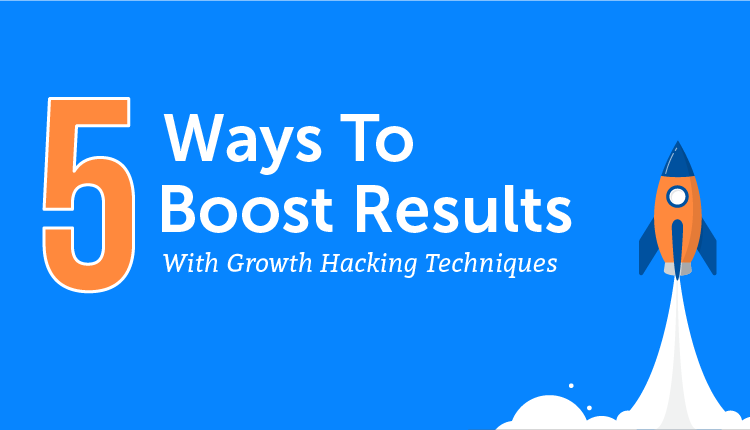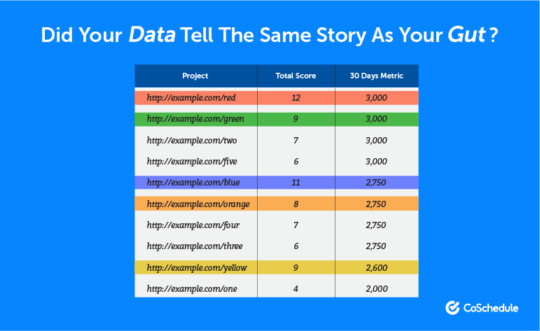5 Ways To Boost Results With Growth Hacking Techniques

As marketers, you want more results. And wouldn’t it be sweet if you could get those results with less (or the same) effort you’re putting in today?
Yeah?
Well, what if I told you some simple marketing optimizations could increase your results by as much as 9,360%? Sound good?
I thought so. 😉
The thing is, you’re likely already doing a lot of the right things. So you can simply focus on a few key improvements that are likely to boost your results even more quickly than would naturally happen.
That’s where the concept of these five *proven* growth hacking techniques come into play. Which has you probably asking yourself…
What Is Growth Hacking… Really?
Marketing growth hacking techniques are frameworks, processes, and optimizations that help you improve your results inorganically faster in repeatable, measurable, and scalable ways.
So… how are these growth hacking techniques different than normal marketing… stuff?
Startups like the one I work at live and die by growth. Not by publishing marketing content. It’s grow… or die.
^^^ See the difference?
Growth hacking is one of the most effective strategies to make the most efficient use of limited resources. In short, it helps you boost huge results super fast.
We’ve used these methodologies at CoSchedule, a marketing and social media calendar, to grow from zero customers to 9,000+, zero email subscribers to 250,000+, and zero pageviews per month to 1.3+ million.
This stuff works.
5 Growth Hacking strategies that grew @CoSchedule's email list from 0 to 250K by @njellering Share on XSo let’s learn about some of the growth hacking techniques that have worked well for launching CoSchedule, shall we? 😉
Let One Metric Guide Every Effort
Focusing on too many metrics or goals—let alone projects—means focusing on nothing at all.

In their book, 4 Disciplines of Execution, authors Chris McChesney, Sean Covey, and Jim Huling anecdotally (and bluntly) suggest:
“Basically, the more you try to do, the less you actually accomplish.”
Narrowing your focus gives you focus.
McChesney, Covey, and Huling continue:
“If you’re currently trying to execute five, ten, or even twenty important goals, the truth is that your team can’t focus. This lack of focus magnifies the intensity of the whirlwind, dilutes your efforts, and makes success almost impossible.”
Their advice to overcome this challenge?
“…when you narrow the focus of your team to one or two wildly important goals, the team can easily distinguish between what is truly top priority and what is the whirlwind.”
At CoSchedule, our demand generation team (and every other team at the company, for that matter) focuses on one core metric at any given time. This gives us the ability to focus every effort on driving results against a single goal.
^^^ So instead of being caught in the whirlwind of trying to boost social media shares, pageviews, unique pageviews, email subscribers, customer count, and world peace while simultaneously reducing bounce rate, email unsubscribes, customer churn, and terrorism we focus on just one simple key performance indicator. (I hope you caught the jokes, btw.)
When CoSchedule started up in 2013, that single KPI was increasing pageviews. Once we scaled that into a repeatable, measurable process, we shifted focus to increasing email subscribers. And again, once we scaled that into a repeatable, measurable process, we shifted focus to generating trial signups.
This strategically foundational growth hacking technique paved the way to help us scale to 1.3+ million pageviews, 40,000+ new email subscribers, and 4,000+ trial signups every single month.

So ask yourself: What is the one goal, the one metric, or the one project I should focus on that makes everything else irrelevant?
Plan Future Projects To Be More Successful Than Your Existing Best Performers
Content is data.
Your past successes (and failures) can help you improve the results of future projects.

This simple growth hacking technique helped us boost results from every new piece of content we published by 299%. It looked a little like this:
- Begin by making a list of all the projects you’ve published in the last three to six months.
- From there, give each project a 1, 2, or 3 rating for each of the following five questions with 1 being low (or poor) and 3 being high (or best): 1) Was the project well optimized to help my audience discover it of their own volition? 2) Did the project cover a topic my audience is deeply interested in learning more about? 3) Was the project well backed with research? 4) Did the project cover the topic in its entirety to truly be the best piece ever created around the topic? 5) Did the project uniquely connect back to my product or service?
- Now gather the stats each project generated toward your goal. I like to give each project the same period of time (e.g. 30 days from publish) so every project has the same timeframe to generate those results.
- Finally, compare your “gut” (or anecdotal) ratings versus hard data. Were the projects you thought to be successful actually prove to be so against your goal? Were there projects you thought were duds that actually produced significant results?

At this point, dissect your top-performing projects to find the trends you’ll replicate in future campaigns:
- Where did the traffic come from?
- Was it the keyword?
- Was it the topic?
- Was it the angle?
- Was it the author or talent?
- Was it the type of content?
- What was the tone?
- …and the list goes on.
^^^ You may also opt to review your worst-performing pieces for commonalities to avoid.
Whether or not you follow this rather tedious yet extremely effective process… Ask yourself: How may I replicate the success from my top-performing projects while consciously eliminating my failures?
Draw Upon Emotion (Yes, Even With B2B)
Content with emotional headlines gets shared more than content that isn’t as emotionally charged.

So what makes for an emotional headline?
You might be surprised to hear this goes beyond classic word definitions, but actually explores the harmonics of the words used and how they influence specific reactions.
^^^ We’ve used data based on that research, an analysis of 1 million headlines in CoSchedule’s database, and 7+ million tests through our headline analyzer to create a word bank of emotionally powerful words you can use in your headlines, subject lines, social media messages, ad copy, and more to help you capitalize upon this opportunity for yourself.
Here’s that emotional word bank tear sheet you can grab completely free to put this into practice now.
Emotion-based headlines drive more clicks to your content, says @njellering. #copywriting Share on XBeyond word choice, however, there are certain qualities to consider within your headlines and content to help them catch on.
In his book, Contagious: Why Things Catch On, author Jonah Berger found six STEPPS behind the psychology of contagious content:
- Social currency
- Triggers
- Emotion
- Public
- Practical value
- Stories
Neil Patel also rounded up several studies to suggest these traits make for very sharable content:
- Curiosity
- Amazement
- Interest
- Astonishment
- Uncertainty
And finally, a few years back, the New York Times Customer Insights Group found their readers shared content that was:
- Valuable
- Entertaining
- Self-defining
- Self-fulfilling
- Relationship-nurturing
- Supportive
Use those qualities within your headlines to draw upon emotion (and subsequently attract an audience who shares your content with a larger audience):
- Resolution: Suggest that your content offers an immediate solution to encourage clicks and shares. Example: 7 Easy Ways To {Do Something} That Will Skyrocket Your {Desired Result} By {#%} In {Timeframe}
- Remarkability: Use trendy words to capitalize on the entertaining, amazing, or astonishing nature of your content. Example: How Spending {Insane Amount Of Money} On {Unsuspected Thing} Made Me {Even More Money}
- Definition: Help people define who they are… and make ‘em feel really good about it. Example: Are You Using {Common Method} To Get {Absurdly High Percentage} More {Desired Result}?
- Practicality: Capitalize on the how-to, actionable, step-by-step headline trends that tend to be among best-performers. Example: The {#}-Minute, {#}-Step Solution For The Best {Desired Result}
A couple other quick headline hacks:
- If you’d like to use a question headline, close-ended questions get 255% more clickthroughs. Example: Want To Get {Absurdly High Percentage} More Results From {Something You’re Already Doing}?
- Using numbers in headlines can boost your clickthrough rate by 206%. Example: This Is The {Desirable Thing} That Will Make You {Crazy High Percentage} More Successful
Ask yourself: How may I connect this headline into the emotional reasons my audience would actually want to consume this content?
Share Your Content More Than Once
You’ve heard the anecdote:
“Most people need to see your message {insert an insane number of times here} before they buy!”
^^^ The actual fact here is that every prospect is different. But in the same breath, apparently, Microsoft did some research and found 6-20 times is kinda accurate. And again… thanks for the really, really broad range there, my friends.
The point, though, is that promoting your content more than once definitely helps you boost results (of that, I’m 100% certain).
Just on social media, we’ve seen content get 3,150% more traffic by simply tweeting nine times in a single week. Here’s a social media posting schedule we rock all the time at CoSchedule to give us at least a 192% boost to each new evergreen piece we publish:

At CoSchedule, we also frequently re-launch evergreen projects (like our marketing and social media strategy courses) as if they’re brand new. The result? Oftentimes, the second, third, and fourth renditions produce higher results than the initial release. (I’ve never written about those results before, so you’re going to have to take my word for it!)
The same goes for sending an email. Noah Kagan got 30% higher email open rates by sending the same email (with a new subject line) one week later to the folks who didn’t open it the first time around.
The point is this: If you think you’ve promoted it enough, you haven’t. One email, one social media message, one push for a large project—it’s not enough.
Ask yourself: What can I do to get this in front of my audience as much and as often as possible (without annoying them)?
Start… Then Never Stop Discovering, Learning, And Iterating
Legendary marketer, Seth Godin, has some of my favorite advice on this topic:
“If you don’t ship, you actually haven’t started anything at all. At some point, your work has to intersect with the market. At some point, you need feedback as to whether or not it worked. Otherwise, it’s merely a hobby.”
From there, I’ve always loved this quote from Zig Ziglar:
“You don’t have to be great to start, but you have to start to be great.”
So why is it that I often see marketers talk about amazing ideas, then never act upon them (albeit, anecdotally)?
There’s uncertainty avoidance, sure (and doing something new is definitely in the *uncertain* bucket). Then there’s also the force field analysis that suggests the forces driving change and the forces resisting change prevent us from changing at all.

So the question becomes, now that you have a handful of new growth hacking techniques to try… and you likely can brainstorm or find tons of others… how can you start new things and ship quickly?
After all… shipping quickly is the ultimate best growth hacking technique.
#GrowthHacking 101: Start… Then Never Stop Discovering, Learning, And Iterating. Share on XIn 1954, Paul M. Fitts discovered three phases of skill acquisition:
- Cognitive skill: This is when you do something just good enough to produce the end result. It’s rough around the edges. It’s where you start.
- Associative skill: This is when you identify and remove errors from your process to smooth out those rough edges.
- Autonomous skill: This is an indefinite improvement where you’re actively reaching for mastery.
Several years later, John R. Anderson added to this research:
- Declarative stage: Learning skill requires instruction and information. Then you need to put what you learn into action.
- Knowledge compilation stage: This is when you practice, repeat, and find a process.
- Procedural stage: Now you’re fine-tuning the process… indefinitely reaching skill mastery.
The takeaway here is that the only way to break through the whirlwind of your lackluster results (and to try new growth hacking techniques) is to hack how you learn new marketing skills.
Consider this:
- Learn how to do something through instruction and information. Then do it. Ship something, warts and all. There will be mistakes. It might help to commit to a publication deadline just to make damn sure you ship.
- Afterward, retro upon what you’ve learned. Make improvements to the process so you make fewer mistakes. There will still be mistakes. Again, commit to publishing by a certain date to make sure you ship.
- Continue publishing, each time looking into how you may remove errors from your process.
All of this suggests you can’t do something once and consider it a skill. More of Anderson’s research suggests it takes 100+ hours to acquire a skill.
Therefore, as a marketer, publishing content consistently is a great way to build new skills.
In his book, The Power Of Habit: Why We Do What We Do In Life And Business, author Charles Duhigg dissects a study that suggests the more you do something, the easier it becomes to do it again.
^^^ Makes sense, right?
So get outside your comfort zone, get out there, go do it.
Before I worked at CoSchedule, I had never written multiple blog posts every single week, started a podcast, hosted webinars, wrote e-books, launched courses, or created interactive tools… let alone managed a kick-ass marketing team.
Skill acquisition, and using the “done is better than perfect” or “shipping > perfection” framework has guided me through all of this.
So that seems like a good place to end it. Good luck as you start, hone, and master your growth hacking techniques!
5 Growth Hacking strategies that grew @CoSchedule's email list from 0 to 250K by @njellering Share on X
